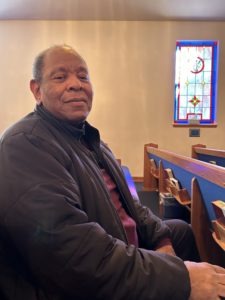
I met Patricia Kelly Adams for the first time this August while I was out in Gallatin working on a story about the Sumner County Colored Agricultural Fair. As I was leaving, she called out an invitation from her porch: “Rose, you’re going to have to go to church with me one Sunday.”
It took me a few months, but sooner or later, I found myself sitting next to Adams, waiting for Sunday service to begin at St. John Missionary Baptist Church, a historic Black church located in Hendersonville. As the pews filled in, she told me that the church was over a century old, with a history that stretched back before Emancipation.
“They built the church on the same rock (where) the slaves used to worship,” she said.
 Rose Gilbert WPLN News
Rose Gilbert WPLN News Dr. Julius Brinkley has been going to St. John’s since he was born. His grandfather was one of the seven men who helped found the church.
After service, Adams introduced me to Dr. Julius Brinkley, deacon and the church’s unofficial historian. One of his most precious memories is his baptism, which took place right across the street in Drake’s Creek over 60 years ago.
“Actually, I was afraid because I was afraid of water. ‘This preacher is going to drown me,’ you know? But as I got older, it was something that I can look back on and appreciate. And I treasure it forever,” he said.
A Drake’s Creek baptism is a tradition that stretches back generations, he explained, back to when this land was part of the Hunter Plantation. The people who were enslaved here used this very spot to worship and perform baptisms. Then, there was no building, just the rock and the creek.
In 1891, seven men — including Dr. Brinkley’s grandfather — bought the land from the Hunter family for $150, and built St. John Missionary Baptist Church.
St. John’s has been through a lot over the years. Its head pastor, Rev. Robert Earl Bell, explained that the church was a target during the Jim Crow era.
“They burned it twice . . . When I came here 38 years ago, it was a block building because the two previous buildings had been burned,” he said.
But they kept rebuilding, on the same site, on the same rock, by that same stretch of creek. The quaint white building you see today is a 21st century renovation, complete with an indoor baptistry and stained glass windows. The original 1891 deed hangs in a frame right by the front door.
“That meant a lot, knowing when it first started,” explained Rev. Bell. “And that’s why it’s important that I put the plaques out in the vestibule, so people can know where they came from.”
Still, that legacy isn’t necessarily common knowledge among the congregation, especially its younger members.
 Rose Gilbert WPLN News
Rose Gilbert WPLN News St. John Missionary Baptist Church’s current building is a 21st century renovation, but the church itself is over a century old.
Kyra Joy Manning, 12, has been coming to St. John’s since she was born. But when she overheard my conversation with Rev. Bell and Dr. Brinkley, she was surprised by how much of the information was new to her.
“I had never learned that the church had been burned down . . . It made me feel confused and lost because I feel so behind on church history,” she said.
But Kyra Joy is doing her own part to keep this church and its legacy alive by performing in the advent play and singing in the youth choir.
“There’s church songs, old church songs that I know word by word, because I’ve been here for so long.”
Although many churches have seen their congregations shrink in recent years, St. John’s has seen a steady flow of new members as a result of folks moving into the area from Nashville, Dr. Brinkley explained.
“We’re not stagnant. We’re not. More members are joining as a result of the overspill of population in Nashville. And a lot of the original members, particularly the young ones, they’re returning back and rejoining the church.”


